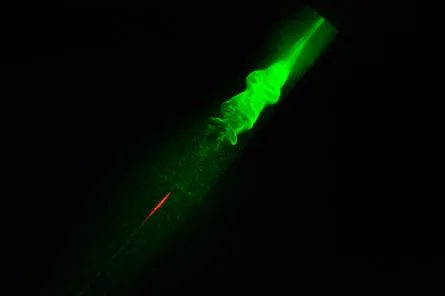- More than 2 years ago
Shooting lasers at the sky can make the germ of a raincloud, a new study shows. In an experiment that smacks of science fiction, scientists used a high-powered laser to squeeze water from air, both indoors and out.

Although the technique is unlikely to be an instant rainmaker anytime soon, it could plant the seeds for more eco-friendly cloud manipulation.
“This is the first time that a laser was used to condense water from both laboratory experiments and from the atmosphere,” says Jér´me Kasparian of the University of Geneva, a coauthor of the study. The work appeared in the May 2 Nature Photonics.
Atmospheric scientists have been trying to build artificial clouds since the 1940s, with mixed success. The most popular method, shooting particles of silver iodide into the sky, relied on the fact that raindrops need something to condense around.
“It’s just like when you take a shower with hot water — it’s very humid in your bathroom, but it’s not raining,” Kasparian says. Water droplets need a surface to condense on, like a mirror in a bathroom or a speck of dust or pollen in the atmosphere.
Previous experimenters hoped droplets would form around flakes of silver, salt or other materials just like on a bathroom mirror. “The idea is, you provide more condensation nuclei, you get more condensation,” Kasparian says. “It seems obvious, but in practice no one could really prove that it works.”
Kasparian and colleagues took inspiration from a mist-making apparatus that was invented in 1911 to detect cosmic rays, highly energetic subatomic particles that come from deep space. A physicist named Charles Wilson noticed that when cosmic rays strike a sealed container filled with water vapor, they leave a visible trail of water droplets behind them. This works because the cosmic rays knock electrons off the water molecules, leaving behind charged particles that act like specks of dust for water to congeal around.
“Our idea was to mimic what happens in a Wilson chamber,” Kasparian says. “If you get some condensation with cosmic rays, we should get even more condensation with a laser.”
Kasparian and his colleagues tested this idea by shooting a high-powered infrared laser into a cloud chamber. The laser shot extremely short pulses of intense light, which each carrying several terawatts — or a trillion watts — of energy.
The view fogged up immediately. Droplets about 50 micrometers in diameter formed first, and grew to about 80 micrometers in diameter over the next three seconds. “The effect in the cloud chamber was very spectacular and visible by bare eye,” Kasparian says. “We expected an effect, definitely. But that magnitude was pretty much a surprise.”
Next, the researchers took the laser out in the backyard to try it on the sky. They rolled the laser, called “Teramobile” for its terawatt power and its mobility, onto the lawn behind the physics building at the Free University of Berlin on several nights in the fall of 2008. The clouds, if they formed, would be too distant to see with the naked eye, so the team used a second laser to confirm the cloudy view.
“It also worked quite well in the free atmosphere,” Kasparian says. “That was quite surprising, and a very good surprise.”
Kasparian thinks lasers could provide a more reliable and environmentally friendly way to build clouds. “If you can seed clouds and get some control or at least modulation on the weather, the implications are huge for agriculture, many other economic sectors, many aspects of human life,” Kasparian says. “There are potentially huge consequences.”
“It is a clever technique,” says John Latham of the National Center for Atmospheric Research in Boulder, Colo. But he’s skeptical that laser-built clouds could actually make it rain on demand. “Rainfall production requires many conditions to be met,” he cautions.







